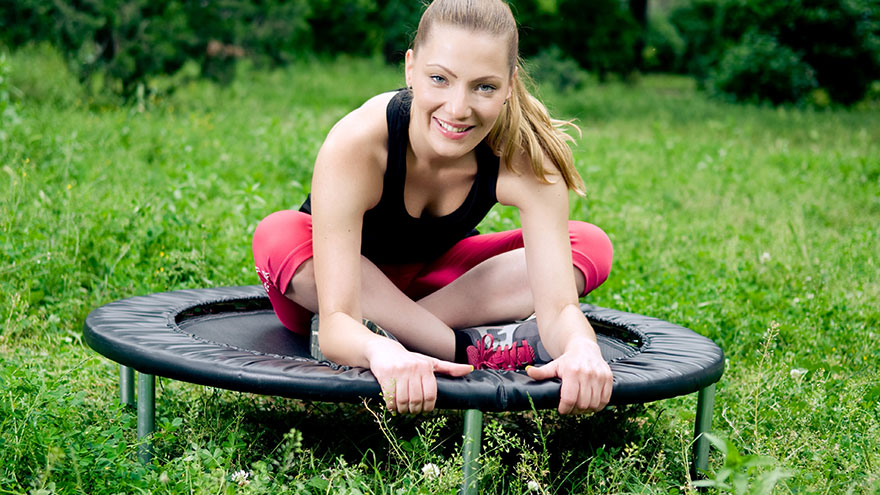How to Lose Weight With a Mini Trampoline
A mini trampoline provides a low-impact but effective workout that can tone your lower body and help you burn calories to lose weight. Rebounding, as jumping on a mini tramp is called, can be adapted to most workout levels and may be found in fitness centers or private studios.
You can also set up a mini trampoline in your own home to fit in several workouts per week. When your goal is weight loss, combine trampoline workouts with a reduced-calorie diet and strength training to get results.

Weight Loss Rules
Losing weight requires a calorie expenditure higher than calorie intake. A mini trampoline can help you increase your calorie output, burning as much as 20 percent more calories than jogging at a pace of 5 mph. For a 155-pound person, this means about 357 calories per half hour, while for a 185-pound person, it could equal 426 calories per half hour.
Trampoline class teacher Parvati Shallow told Marie Claire that six minutes of rebounding can be equal to a mile of jogging, provided you jump continuously at a strong, rhythmic pace. Classes held at large trampoline centers, which include core work, jumping and calisthenics, may burn as much as 1,000 calories per hour. Since you must burn 3,500 calories more than you consume to slim down just 1 pound, these can help get you there expediently.
Increased Intensity
A slow, methodical bounce or low-impact walking may be a good way to start your trampoline jumping program if you’re new to working out, but as you become more fit, you’ll need to add intensity to benefit from a high calorie burn.
Jog in place and add tight jumping jacks, ballet squats and tuck jumps to increase the difficulty level and raise your heart rate. You don’t have to catch a lot of air to make these moves effective, because your entire body has to stay activated to keep you balanced and upright while jumping on the trampoline.
Stick With It
Regular rebounding sessions are the key to losing weight. You’ll want to rebound at least 150 minutes per week for health, and you may need to jump more often to lose weight. Other cardio activities, such as walking, jogging, swimming and aerobic dance, complement trampolining and can help you fit in more of these minutes weekly.
Listen to music or watch television if you jump at home to keep yourself from getting bored. Sign up for a regular class if there’s one nearby; paying in advance may help keep you committed.
Additional Weight-Loss Strategies
Two to three times per week, after your trampoline session, do a strength-training workout that targets all the major muscle groups. You could stand on the floor next to your trampoline and do squats and lunges; use dumbbells for shoulder presses, triceps kickbacks, biceps curls and back rows. Finish a strength circuit with pushups — put your hands on either side of the mini trampoline — and plank holds.
Do one set of each exercise for eight to 12 repetitions and work your way up to heavier weights and more sets over several weeks. The strength training will build muscle mass, which helps you burn more calories all day long — when trampolining and not. A diet consisting of mostly lean proteins, whole grains, vegetables and fruits will also support your weight-loss efforts.
You may find that the combined effort of eating better and the stimulating quality of rebounding, which positively affects your toxin-cleansing lymphatic system, will help you feel more energized and healthy as well as lighter.
You Might Also Like :: How Many Calories Does Skating Burn?

